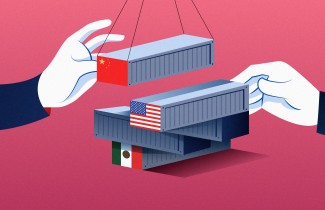KPIs and Motivation: When Less Is More
The right amount of feedback improves team performance at a lower cost

Some people treat KPIs as if they were sacred. Today, many teams operate under the rule of performance metrics: if something is quantifiable, it’s measured; if it’s not, a way to measure it is invented. We’ve grown accustomed to dashboards full of indicators, meetings driven by numbers, and continuous performance monitoring. But amid this obsession with metrics lies a paradox: many fast-scaling startups begin without KPIs, dashboards, or defined goals. Instead, they rely on intuition and execution.
This approach often works for a while. However, as these startups grow, expand their teams, and face more complex management challenges, their pace begins to falter—this is when they implement KPIs. Improvisation gives way to processes, growth slows, and employees start paying more attention to dashboards than to customers. Tools originally meant to improve performance begin to erode the very factors that made the company stand out. This raises an important question: why do high-performing teams thrive on limited information but struggle when more data becomes available?
The classic argument in favor of KPIs is that they serve two main purposes:
- Provide feedback: KPIs show which efforts are effective, highlight problems, and help navigate uncertainty.
- Make performance visible: KPIs help leaders focus attention, reward employee efforts, and detect underperformance.
In theory, KPIs make organizations more efficient and accountable, assuming visibility leads to better performance. In practice, however, human effort doesn’t work exactly this way. Clearer feedback doesn’t always lead to more focused action—and sometimes, it backfires.
When feedback is scarce, sustaining effort becomes costly. If employees lack clarity about their impact, companies often resort to compensation to maintain a baseline level of engagement. This poses a risk, as high investment doesn’t always guarantee effective output. Incentives may become costly—such as large bonuses or inflated salaries—merely masking the company’s lack of direction.
Conversely, offering too much visibility can be just as risky. When employees can clearly see their chances of success through metrics, motivation may decline. If success seems guaranteed, there’s no urgency to push forward; if it appears unattainable, effort plummets. In both cases, companies end up investing more than they gain.
Motivated Uncertainty
According to my latest working paper, Opaque by Design, the most effective approach lies in a middle ground. In this space—what I call motivated uncertainty—people are unsure of the outcome but believe their actions can still make a difference. The goal isn’t to obscure or confuse, but to offer just the right amount of feedback to preserve belief. When people feel their effort might tip the scales, they stay engaged, push harder, and adapt more quickly.
Why does this happen? It’s not merely a behavioral trick—it’s an economically optimal strategy. My research shows that when effort is hard to monitor and bonuses are costly, partial transparency yields better results at a lower cost. A well-designed KPI doesn’t just reflect performance; it shapes belief. And belief, when cultivated thoughtfully, becomes a powerful tool to sustain effort without inflating compensation.
This logic also applies in high-performance settings, where motivation matters and outcomes are difficult to predict. In the military, for instance, commanders don’t tell their teams the exact odds of mission success (“we have an 87% chance of winning”)—instead, they describe the conditions in general terms. The aim isn’t to conceal intelligence, but to preserve alertness. When people believe the outcome depends on them, they remain focused and motivated—more so than when they feel the outcome is already decided.
The same pattern appears in top consulting firms. Managers rarely offer conclusive feedback on whether a client account will be secured, even if they suspect the likely result. It’s not about withholding truth—it’s about understanding that when consultants perceive the decision as final (whether positive or negative), their effort declines. When they feel the result is still in play, they work harder.
Research supports this view. Ambiguous signals help people stay flexible and committed (Gavetti, Levinthal & Ocasio, 2007). In some cases, leaders even soften feedback—intentionally or not—to preserve motivation, creating a sort of fog that paradoxically sharpens effort (Fisher & Ashkanasy, 2000). More recent studies show that future-oriented feedback—focused on trajectory rather than outcome—can more effectively enhance performance (Steelman, Levy & Snell, 2020). The principle is clear: when people believe their effort still matters, they keep going.
The Power of Ambiguity
My work builds on these findings and formalizes them as a contractual design problem. Traditional economic models rely on performance-based incentives—bonuses for success, penalties for failure—but this becomes expensive when effort cannot be observed. If you can’t tell whether someone is truly trying, you either assume the worst or overpay to compensate.
My model introduces a third lever: belief. Instead of depending solely on money or surveillance, it’s possible to shape what people believe about their own impact. When well-designed, this belief can drive real effort at lower cost. By managing what people know about their likelihood of success, you influence how much they value their own contribution. Optimistic signals allow for relaxed compensation, while weaker signals justify increased bonuses to sustain motivation.
The key is that these signals must be imperfect. When people know too much, they disconnect or become complacent; but if they remain in a state of uncertainty—when outcomes seem open-ended—companies elicit greater effort with lower investment. In this case, ambiguity is not a flaw—it’s a feature of the contract.
Using KPIs with Intention
This approach has major implications for how KPIs are used in teams. Most companies treat these indicators as objective truths—purely descriptive tools. Yet the most effective metrics are deliberately imprecise. They don’t deceive, but they shape belief. A KPI that says “you’re on the right track” rather than “you’ve reached 83% of your target” maintains motivation; a dashboard that reads “we’re gaining ground” keeps outcomes open and urgency high.
The goal of such KPIs isn’t to hide information—it’s to be intentional. When metrics define the outcome too early—suggesting the path is either fully cleared or already lost—effort drops. Belief, not certainty, drives performance. And belief can be designed.
The same logic applies to compensation: bonuses don’t have to be fixed. They can adjust based on the perceived likelihood of success. When a project nears completion and everything looks promising, there’s no need to overspend. But when the outcome remains uncertain—and effort could tip the balance—that’s when strong incentives matter most. It’s not about slashing salaries or flattening rewards—it’s about aligning pay with the value of effort in each phase. This means spending smarter, not necessarily less.
As companies grow, they naturally feel the need to systematize: more metrics, more KPIs, more visibility. But in chasing precision and overexposing results, many lose their sense of urgency and competitive edge—spending more for less performance. Bureaucracy swells while motivation wanes, and compensation costs spiral upward. These companies miss the chance to shape belief—an underestimated lever that, when managed well, drives performance more effectively than any metric.
These insights don’t suggest abandoning KPIs altogether but rather learning to use them intentionally. A good KPI isn’t just a progress bar—it’s a lever, a message, a way to keep people engaged. When used wisely, KPIs not only reflect a team’s current state, but also guide their next steps.
Today’s obsession with metrics isn’t inherently bad—but organizations would do well to learn from high-performance environments—startups, special forces, elite teams—that understand a deeper truth: effort depends less on what is visible, and more on whether people believe their actions still matter. In the end, lack of transparency isn’t necessarily a flaw. Used wisely, it’s not just effective—it can be optimal.
The author is Research Professor, Department of Finance and Business Economics, EGADE Business School.
References:
Gavetti, Giovanni, Daniel A. Levinthal, and William Ocasio. 2007. “The Fog of Feedback: Ambiguity and Firm Responses to Multiple Aspiration Levels.” Strategic Management Journal 28 (1): 25–44. https://doi.org/10.1002/smj.569.
Fisher, Cynthia D., and Neil M. Ashkanasy. 2000. “The Illusion of Transparency in Performance Appraisals: When and Why Accuracy Motivation Explains Unintentional Feedback Inflation.” Journal of Organizational Behavior 21 (7): 741–57. https://doi.org/10.1002/1099-1379(200011)21:7<741::AID-JOB55>3.0.CO;2-V.
Steelman, Lisa A., Lisa M. Levy, and Jennifer R. Snell. 2020. “The Future of Feedback: Motivating Performance Improvement through Future-Focused Feedback.” Organizational Dynamics 49 (1): Article 100709. https://www.ncbi.nlm.nih.gov/pmc/articles/PMC7304587/.



